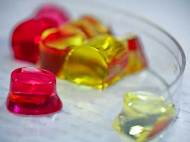Hydrogel that can self-heal in aqueous environment
 University of California, San Diego bioengineers have developed a smart and easy-to-synthesize self-healing hydrogels that consist of linked chains of polymer molecules which are capable to self-heal in aqueous environment. This jello-like material’s ability to self-heal, bind in seconds and form a bond strong enough to withstand repeated stretching could find uses in biology, medicine, and engineering.
University of California, San Diego bioengineers have developed a smart and easy-to-synthesize self-healing hydrogels that consist of linked chains of polymer molecules which are capable to self-heal in aqueous environment. This jello-like material’s ability to self-heal, bind in seconds and form a bond strong enough to withstand repeated stretching could find uses in biology, medicine, and engineering.
“Self-healing is one of the most fundamental properties of living tissues that allows them to sustain repeated damage”, said team leader Shyni Varghese, Assoc Professor at the UCSD’s Department of Bioengineering. “Being bioengineers, one question that repeatedly appeared before us was if one could mimic self-healing in synthetic, tissue-like materials such as hydrogels. The benefits of creating such an aqueous self-healing material would be far-reaching in medicine and engineering.”
The researchers managed to create self-repairing hydrogels with the use of “dangling side chain” molecules that extend like fingers on a hand from the primary structure of the hydrogel network and enable them to grasp one another. According to them, the self-healing hydrogels they developed remain healed over a wide range of temperatures, light conditions, and humidity.
To design the side chain molecules of the hydrogel that would enable rapid self-healing, Varghese and her collaborators performed computer simulations of the hydrogel network. The simulations revealed that the ability of the hydrogel to self-heal depended critically on the length of the side chain molecules, or fingers, and that hydrogels having an optimal length of side chain molecules exhibited the strongest self-healing.
They found that acryloyl-6-aminocaproic acid (A6ACA) precursors possess an optimal balance of hydrophobic and hydrophilic interactions, and that when two cylindrical pieces of gels featuring these optimized fingers were placed together in an acidic solution, they stuck together instantly. Varghese’s research group further found that by simply adjusting the solution’s pH levels up or down, the pieces weld (low pH) and separate (high pH) very easily. The process occurs within seconds, and it was successfully repeated numerous times without any noticeable reduction in the weld strength.
This ability makes the material a promising candidate to seal leakages from containers containing corrosive acids. In order to test the effectiveness of the hydrogel, the researchers coated various surfaces with A6ACA hydrogels and mechanically damaged the coatings with 300-μm-wide cracks. The coatings healed the damage within seconds upon exposure to low-pH buffers (acids).
UC San Diego researchers also performed an experiment where they drilled a hole in a polypropylene container which they coated with A6ACA hydrogel. After they poured hydrochloric acid into the coated container, the hydrogel instantly sealed the hole and prevented any leakage of the acid. The researchers hope they will synthesize other varieties of hydrogels capable to self-heal at different pH values, thereby extending the applications of such hydrogels beyond acidic conditions.
Aside the application in industry, it could be used to reduce industrial and consumer waste and thus increase energy conservation and recycling. In medicine, it could be used as a form of tissue adhesives for stomach perforations or as assistance in drug delivery in cases where they could store and release bioactive molecules without compromising their activity.
For more information, you can read the article published in the Proceedings of the National Academy of Sciences: “Rapid self-healing hydrogels”.









Leave your response!